John Singer Sargent painted watercolors most
of his life, but until about 1900 he did so only fitfully and, as he said,
to "make the best of an emergency."1 By about 1900 Sargent had tired
of formal portraiture. "No more paughtraits," he wrote
his friend Ralph Curtis. "I abhor and abjure them and hope never to do
another especially of the Upper Classes."2 He could never give up portraiture
entirely, despite his hope, but he did, as Richard Ormond has nicely put,
go "off duty"3 to paint other subjects and work in other mediums.
Of those subjects, Venice was his favorite, and watercolor
was the medium he favored to paint it. Sargent had visited Venice before
1900, of course; some twenty years earlier he had done a beautiful series
(in oil) of Venetian street scenes and interiors. But from about 1900 to
1913, when "swarms of smart Londoners" managed to drive him away,4 he visited
Venice almost yearly, and he painted it most often by far in watercolor
(the majority of Sargent's late watercolors are Venetian). Sargent's earlier
oils were painted on solid ground and depicted the "Venice in Venice that...others
seemed never to have perceived" that Whistler had discovered slightly earlier,5
the Venice of back streets, small squares, and interiors that tourists
seldom saw and artists seldom depicted. His later Venetian watercolors
are painted from "gondola perspective"6 as he floated through the city's
canals (they often include the prow of his gondola to make that point of
view explicit), looking at its buildings and depicting its major architectural
monuments and public spaces. They are painted not only with the seemingly
effortless fluency that characterizes Sargent's work in every medium, but
with a
fluidity -- a wetness both of appearance and of the process
by which Sargent painted them --that befits the consistently watery perspective
from which Sargent observed Venice, the "perpetual fluidity beneath"7 him
as he floated effortlessly through the city.
In depicting figures, Gondoliers' Siesta is something
of a rarity among Sargent's later Venetian watercolors (as is the fact,
too, that it is dated, 1905). And instead of the clear blue skies and vibrantly
coruscating light of most of Sargent's Venetian watercolors, Gondoliers'
Siesta is, with its overcast sky, more subdued, more languid, shadowy,
and even mysterious. In all these respects it recalls, more than most of
Sargent's Venetian watercolors, the dark streets and alleys and slightly
sinister occupants of his first Venetian series of the 1880s.
Nicolai Cikovsky, Jr.
Senior curator of American and British paintings
Notes
1. Evan Charteris, John Sargent (London, 1927), 95.
2. Quoted in Charteris 1927, 155.
3. John Singer Sargent: Paintings, Drawings, Watercolours
(London, 1970), chap. 5.
4. Charteris 1927, 171.
5. Letter to Marcus B. Huish, probably January 1880,
Glasgow University Library, quoted in Richard Dorment et
al., James McNeill Whistler [exh. cat.,
Tate Gallery] (London, 1994), 179.
6. The term is Tony Tanner's, Venice Desired (Cambridge,
Mass., 1992), 173, apropos Henry James: "perpetual
architecture above you and perpetual fluidity
beneath" (Italian Hours [New York, 1958], 19 - 20). It is cited in
Donna Seldin Janis, "Venice," in Sargent
Abroad: Figures and Landscape (New York, 1997), 186.
7. See note 6, above.
Copyright ©1999 National Gallery of Art, Washington
D.C.

Palmettos (1917), watercolor.
Robbie and Sam Vickers Collection.
Copyright © 1999 National Gallery of Art, Washington
D.C.
In 1916, Sargent left Europe for a two-year visit to the
United States, to oversee the final installation of the Boston Library
murals. While in Florida to paint a portrait of John D.
Rockefeller, he was attracted to the luxuriant
vegetation of the near-tropical climate and painted several watercolors
of Palmettos . In the close-up depiction of the sunlit palms, he
explored the geometric shape of the plant to create
intricate patterns.
Copyright ©1999 National Gallery of Art, Washington
DC.

